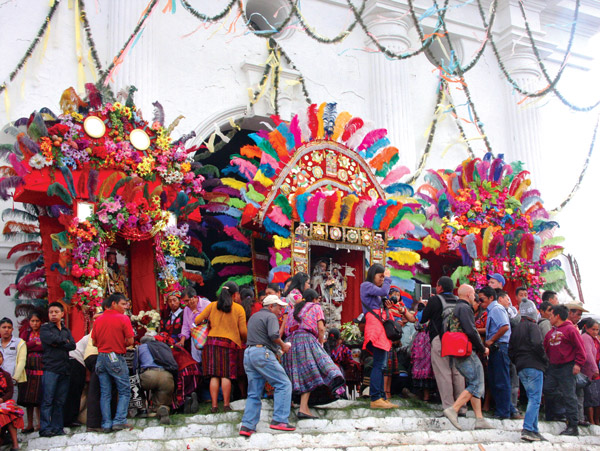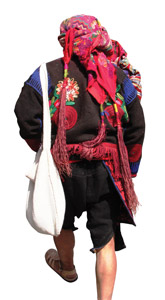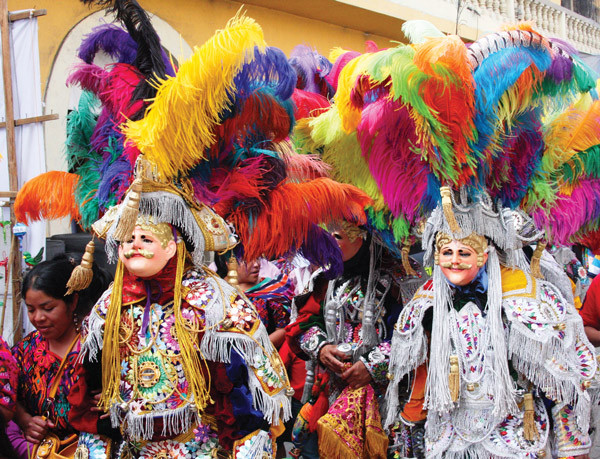The Festival of Santo Tomás in Chichicastenango, Guatemala
It was Sunday, Dec. 21, as I headed out for yet another adventure to the magical Mayan village of Chichicastenango set in the western Highlands of Guatemala. On Thursdays and Sundays, the native K’iche’ Maya turn this remote mountain village into one of the world’s most famous markets. Today, however, was particularly special because it was the culmination of a week-long festival that began on Dec. 13, honoring the town’s patron saint, Santo Tomás.
Our bus zigzagged around a hillside where the vegetation was dominated by a prickly, nettle-like plant with purple blossoms called the chichicaste. Chichicaste is the Guatemalan equivalent of poison ivy, hence the town’s namesake – Chichicastenango – affectionately known to locals as Chichi.
I strolled to the east end of the main square to the steps of the glowing white Dominican church of Santo Tomás built over 400 years ago by the Spanish, site of most of the festivities. The streets were packed and the steps in front of Santo Tomás Church, normally overflowing with flower vendors, were on this day the site of massive fireworks and explosives.
To say that Guatemalans love their pyrotechnics would be an understatement and the festival of Santo Tomás is no exception. Teams of men work nonstop to ensure that something is exploding and sparkling somewhere at each and every moment throughout the day.
I had obviously gotten too close because I was being hit all over, including in the face, with scraps from the explosives. The 18 steps leading to the doorway of the church were covered in mounds of dust and remnants of the fireworks.
Even more impressive is the spectacle of the Palo Volador, involving costumed dancers, climbing to the top of a very tall pole, and then tying rope to their ankles before jumping off a platform and spiraling down head first to the ground. You just have to hold your breath and hope for the best.
Chichicastenango is already a riot of brilliant color with its intricately embroidered textiles and handicrafts spilling out onto the streets, but during the Festival of Santo Tomás, hundreds of Guatemalans wear even more elaborate costumes and fancy masks, turning themselves into dancing Spanish conquistadors.
Adding to the street party atmosphere, the Dance of the Conquest, which occurs several times during the course of the festival, re-enacts the period in history when the Spanish ruled Guatemala.
Although this festival honors a saint, the celebration is in reality a blending of K’iche’ Mayan and Christian traditions. No other church in Guatemala is as good an example of this concept of syncretism—the blending of religions—as is Santo Tomás in Chichi. The entire K’iche’ tribe is long since Christian, yet Mayan ceremonies and many of its ancient rites and beliefs persist in daily life.
According to Ignacio Ochoa, director of the Nahual Foundation, a think tank by and for indigenous people of the Americas, Dominican priests first worked as missionaries here from 1539 to 1850 before Santo Tomás Chichicastenango became an actual parish. “These missionaries created the cofradías, a kind of brotherhood of community leaders with varying ranks and responsibilities that are both religious and political in structure,” said Ochoa.
There are 14 cofradías in Chichi, each representing a different saint. On the celebration day of its respective saint, the cofradía wears ceremonial dress and marches in a procession through town carrying a float with its namesake saint, in this case Santo Tomás.
“Another important tradition on the day of the Festival of Santo Tomás,” explained Ochoa, “is the transfer of power of head members of the cofradía to the majordomo who serves a one-year term and is responsible for all matters pertaining to their patron day celebration.”
The passage of power occurs at the home of the outgoing majordomo in a formal ceremony in which a wooden baton decorated with silver is handed to the newly elected majordomo. The public and tourists are all welcome to witness the ceremony. The majordomo of the patron saint of Santo Tomás clearly holds the most prominent and respected role in the community.
— text and photos by Kerstin Sabene



¿Splendorous? Can´t think of a better word to describe the representations in the se pictures.